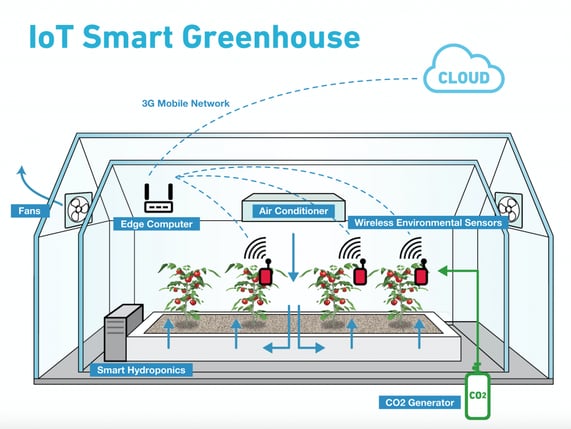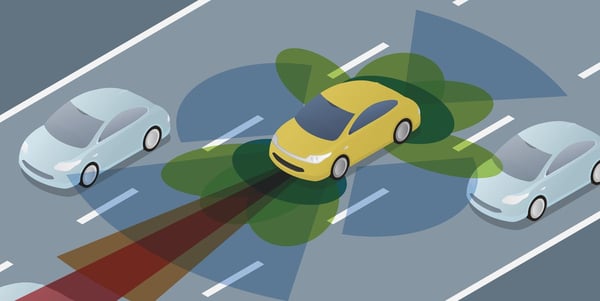Around the world, cities are looking for ways to further develop with the help of technology, and one option is collecting data of a city’s daily activities for analysis. This information can come from security cameras, smartphones, electronic surveys, applications such as Waze, social media, and other sources. In this way, a city’s services can be optimized by analyzing and finding patterns in the collected data. For example, depending on the density of traffic at a particular hour, traffic lights could be strategically placed and controlled to avoid traffic jams. There is also the possibility of automatically determining the right temperature and humidity for a greenhouse based on plant and environmental conditions. In addition, based on a person’s internet searches or by analyzing information they share on social media, websites of interest can be recommended.
Currently, many devices generate real-time data that is sent to a server or is stored in the cloud. This process is part of the concept of the Internet of Things (IoT). Once the data has been stored, it is processed and can be used to design a machine learning (ML) model that finds patterns in the data.
ML along with IoT are essential components of smart cities. The concept of a smart city implies using technology and data analysis to optimize services in different areas - such as communication, agriculture, public services, among others - to enhance residents quality of life.
Some of the applications of artificial intelligence that are part of smart cities include smart urban agriculture, traffic control through automatic signaling, autonomous vehicles, automatic cleaning machines, smart homes, etc. Unbeknownst to us, through these various technologies, we are getting closer to living like ‘The Jetsons’, where different autonomous machines can learn to perform day-to-day tasks by themselves and execute them efficiently.
Smart Urban Agriculture
Vertical agriculture or urban agriculture has been encouraged in densely populated cities. Due to the expansion of cities, nearby areas of available and fertile land for planting have been reduced. Therefore, people have started - as a hobby or as a business - to combine IoT with artificial intelligence to create self-governing gardens or orchards. For these units to work, they have to be set up within a greenhouse with multiple sensors, as can be seen in Figure 1. It is tedious for a single person to be constantly changing the environment of a greenhouse. The idea is for the greenhouse to do it by itself, adapting to the needs of the plants.
This type of garden can’t be created from one day to the next since data needs to be sent to a server for storage. Afterward, an expert in plant breeding along with a data scientist must analyze the information to guarantee its quality. After that, a model can be trained using ML to predict an ideal environment according to the health and requirements of the plants.
Figure 1. Vieru C, 2019. AWS IoT-Driven Precision Agriculture. Taken from: https://aws.amazon.com/blogs/iot/aws-iot-driven-precision-agriculture/
Autonomous Vehicles
Autonomous vehicles are a technology that has been in development for years. This is a polemic technology since there is no human controlling the car and because of this, it’s thought that it could cause unexpected accidents.
An autonomous vehicle has a series of sensors that monitor the state of its environment, as can be seen in Figure 2. These sensors allow the car to perceive the environment through which it moves; be it assessing the roads, determining if there are any pedestrians, or recognizing traffic signals or other vehicles.
Autonomous vehicles are trained using virtual simulators. These simulators recreate a similar environment to what the car will encounter in real life, with pedestrians, traffic signals, and other cars. The training is done with simulators to prevent traffic accidents in real life and because it is more practical and cost-effective.
To train an autonomous vehicle, a simulator uses reinforcement learning (a sub-branch of ML), a type of automatic learning where the agent (the car in this case) learns which actions it must take through reinforcement (reward or punishment). For example, if the car runs over a pedestrian in the simulator, it will be given a ‘punishment’; but if it follows the road correctly and doesn’t crash, it will be given ‘rewards’. When it achieves an adequate performance, the model is then used in a real car.
It should be remembered that when an ML model is used, this does not mean the car will drive perfectly. A model will always keep making mistakes from which it learns and, with time, will reduce them.

Figure 2. Baldwin R, 2020. IIHS Study: Autonomous Cars Won't Avoid Majority of Vehicle Crashes. Taken from:: https://www.caranddriver.com/news/a32783046/iihs-autonomous-cars-not-as-safe-study/
Marketing
Who hasn’t gone through the experience of having a chat with a friend about a product, only to ‘surprisingly’ encounter ads related to that product on social media? Well, one of the services that can be provided in smart cities is product recommendations to potential buyers.
For example, there are shopping centers that can detect a person’s location using their smartphone’s GPS. Thanks to this technology, they can determine which shops certain people visit more often and what products they are interested in. It is also possible to use facial recognition (deep learning) to achieve similar marketing objectives.
Automatic Cleaning
Many of us would like to have a Roomba, a Conga, or an Ecovacs Deebot since these vacuum cleaners are pretty practical and help us not to worry about cleaning the floors. Well, every smart vacuum cleaner has a set of sensors that allow it to know which objects can be found all around. Just like autonomous vehicles, these vacuum cleaners use reinforcement learning to learn how to move over surfaces in the most efficient way possible.
Smart vacuum cleaners help optimize cleaning in homes, public hospitals, and health care institutions. When rigorous disinfection is required due to a particular illness, this type of technology prevents people from coming into contact with contaminated surfaces and avoids the spread of illness.
Conclusion
Currently, there are many tools - such as IoT and ML - that help optimize different day-to-day tasks. What was once done manually - like driving a car or cleaning a house - can now be done automatically with the help of IoT and ML. It must be taken into account that although the applications of artificial intelligence mentioned in this article may achieve high levels of performance, this does not mean they will not make mistakes.
References
Chatterjee S., Banerjee P. y Nasipur M.,2018. Machine learning for internet of things data analysis: a survey. Taken from: https://reader.elsevier.com/reader/sd/pii/S235286481730247X?token=E0EDC6FB2C0434228E18DBA48E4F2D61E28DDCDC307A3D93C2433C78ABC4D501C0B769799BE60E341EACC85A9D208C4A
Gurav P., 2019. Artificial intelligence & machine learning: The brain of a smart city. Taken from: https://jaxenter.com/smart-city-ai-ml-164124.html
Rees K. [ScienceLogic], 2017. Machine Learning Enhances IoT Gardening with ScienceLogic. Recuperado de https://www.youtube.com/watch?v=02AeF9N5gGM
Way T. [Microsoft Developer], 2018. Machine Learning in IoT solutions. Taken from: https://www.youtube.com/watch?v=Ro0S9DfzxfY
KEY TAKEAWAYS
|
